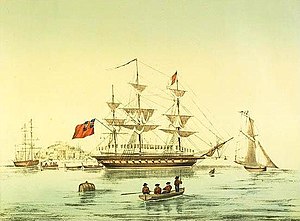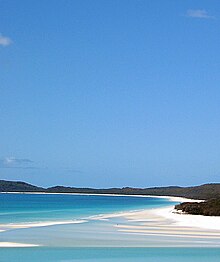HMSFly(1831)
 Flyoff Sydney c.1842
| |
| History | |
|---|---|
| Name | HMSFly |
| Ordered | 30 January 1829 |
| Builder | Pembroke Dockyard |
| Cost | £11,761 (plus £4,648 for fitting out)[a][1] |
| Laid down | November 1829 |
| Launched | 25 August 1831 |
| Commissioned | 27 January 1832 |
| Out of service | Converted to a coal hulk in 1855 |
| Renamed | C2and laterC70whilst a hulk |
| Fate | Broken up 1903 |
| General characteristics | |
| Class and type | Fly-classship-sloop |
| Tons burthen | 48569/94bm |
| Length |
|
| Beam | 31 ft 7 in (9.6 m) oa |
| Depth of hold | 14 ft 5 in (4.4 m) |
| Sail plan | Full-rigged ship |
| Complement | 120 |
| Armament |
|
HMSFlywas an 18-gunsloopof theRoyal Navy.She was responsible for the exploration and charting of much of Australia's north-east coast and nearby islands. She was converted to a coal hulk in 1855 and broken up in 1903.
Design and construction
[edit]Flywas a development of theOrestes-classship-sloopdesigned by Professor Inman of theSchool of Naval Architecture.She was 114 feet 4 inches (34.8 m) long on the gundeck and93 feet6+1⁄8inches (28.5 m) at thekeel.She had abeamof 31 feet 7 inches (9.6 m) overall, and a hold depth of 14 feet 5 inches (4.4 m), giving her atonnageof 48569/94bm.Her armament was made up of sixteen 32-poundercarronadesand a pair of 9-pounderbow chasers.[1]
Flyand her three sister shipsHarrier,ArgusandAcornwere ordered on 30 January 1829. She was laid down in November 1829 and launched fromPembroke Dockyardon 25 August 1831.ArgusandAcornwere cancelled on 27 April 1831, leavingFlyas the lead ship of a class of two.[1]
Service
[edit]She was commissioned at Plymouth on 27 January 1832 under the command of Commander Peter M'Quhae[2]and served initially on theNorth America and West Indies station,returning to Portsmouth on 30 September 1833. After another two years on the same station she paid off at Portsmouth on 5 September 1835. By September 1836 she was fitting out for the South America station, including work in the Pacific Ocean. She was under the command of CommanderGranville Gower Lochon that station from 1838 to 1840.[3]She arrived atSpitheadon 17 July 1840 from South America with 1,700,000 dollars and sailed for Plymouth to be paid off. In December 1841 she commissioned at Plymouth under the command ofFrancis Price Blackwoodto survey theTorres Straitin company with the cutterBramble.[4]
During the early to mid-1840s, she charted numerous routes through and from many locations aroundAustralia's north-east coast and nearbyislands,includingWhitsunday Islandand theCapricorn IslandsinQueensland.[5]During this part of her service she employed the painter and draughtsmanHarden Sidney Melvilleto produce the first official hydrographic survey of the north-east coast of Australia.[6]On 2 September 1844, she rescued the survivors of the British merchant shipLady Grey,which had been wrecked on Alert's Reef the previous day with the loss of a passenger whilst on a voyage fromSydney,New South WalestoSingapore.[7][8]
After being discovered during the survey of theGulf of Papua,New Guinea,theFly Riverwas named after the ship. Embarked during her voyages of exploration were the geologist and naturalistJoseph Jukesand the naturalistJohn MacGillivray.[5]
Flyreturned to the United Kingdom, arriving atSpitheadon 19 June 1846 and proceeded toPlymouthto pay off. She was commissioned again on 14 October 1847 under Commander Richard Oliver,[2]and was employed in surveying in the Pacific and New Zealand. After 4 years of work in the area she returned to the United Kingdom, arriving at Plymouth Sound on the evening of 4 December 1851 and paying off on 13 December.[4]
Fate
[edit]
She was laid up as a coal hulk atDevonportin 1855. During this part of her career, she was renamedC2,and thenC70.She was finally broken up in 1903.[1]
See also
[edit]Notes
[edit]- ^A total cost accounting for inflation of approximately £1,882,000 in today's money.
Citations
[edit]- ^abcdWinfield (2004), p. 120
- ^ab"HMSFlyat the William Loney website ".Retrieved10 September2011.
- ^Laughton 1893,p. 25.
- ^ab"HMSFlyat the Naval Database ".Retrieved10 September2011.
- ^abMozley, Ann."Francis Price Blackwood (1809–1854)".Blackwood, Francis Price (1809 - 1854).Australian Dictionary of Biography.Retrieved10 September2011.
- ^Melville, Harden Sidney."Harden Sidney Melville".Design & Art Australia Online.Retrieved28 November2020.
- ^"Ship News".The Times.No. 18813. London. 6 January 1845. col D, p. 8.
- ^"Calcutta".The Australian.Sydney. 13 March 1845. p. 2.
References
[edit]- Colledge, J. J.;Warlow, Ben (2006) [1969].Ships of the Royal Navy: The Complete Record of all Fighting Ships of the Royal Navy(Rev. ed.). London: Chatham Publishing.ISBN978-1-86176-281-8.
- Jukes, J. Beete (1847),Narrative of the surveying voyage of H.M. S. Fly commanded by Captain F. P. Blackwood, R.N., in Torres Strait, New Guinea, and other islands of the Eastern Archipelago, during the year 1842-1846: together with an excursion into the interior of the eastern part of Java,London T. & W. Boone
- Laughton, John Knox (1893)..InLee, Sidney(ed.).Dictionary of National Biography.Vol. 34. London: Smith, Elder & Co. pp. 25, 26.
- Winfield, R.; Lyon, D. (2004).The Sail and Steam Navy List: All the Ships of the Royal Navy 1815–1889.London: Chatham Publishing.ISBN978-1-86176-032-6.OCLC52620555.
External links
[edit] Media related toHMS Fly (1831)at Wikimedia Commons
Media related toHMS Fly (1831)at Wikimedia Commons
